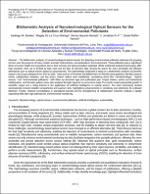| dc.contributor.author | Benites, Santiago M. | |
| dc.contributor.author | De La Cruz-Noriega, Magaly | |
| dc.contributor.author | Nazario-Naveda, Renny | |
| dc.contributor.author | R.-F., S. Jonathan | |
| dc.contributor.author | Delfin-Narciso, Daniel | |
| dc.date.accessioned | 2025-09-05T15:25:54Z | |
| dc.date.available | 2025-09-05T15:25:54Z | |
| dc.date.issued | 2025-07-15 | |
| dc.identifier.uri | https://hdl.handle.net/20.500.13067/3997 | |
| dc.description.abstract | The bibliometric analysis of nanotechnological optical sensors for detecting environmental pollutants addresses the growing concern over the presence of heavy metals, aromatic hydrocarbons, and pesticides in the environment. These pollutants pose a significant threat to human health and ecosystems due to their toxicity and bioaccumulation potential. While traditional analytical techniques offer high precision, their use is limited by high costs and the lack of real-time data, driving the search for more accessible and efficient alternatives such as optical sensors based on nanomaterials. The methodology employed is based on a bibliometric analysis of scientific output in the Scopus database from 2010 to 2025. Tools such as VOSviewer and Bibliometrix in RStudio were applied to identify research trends, collaboration networks, and key actors. Search criteria were established, considering terms like "nanotechnology," "optical sensors," and "environmental pollutants," with filters by document type and publication year. Impact metrics, author and institutional collaboration, and thematic patterns were also analyzed through keyword co-occurrence maps.The results reveal exponential growth in scientific output and a rising interest in the application of artificial intelligence in optical sensors. The most extensively studied nanomaterials include metallic nanoparticles and quantum dots, highlighting advancements in sensitivity and selectivity for pollutant detection. Finally, research consolidation in specialized journals and the strengthening of collaboration networks indicate a rapidly expanding field with high potential for environmental monitoring. | es_PE |
| dc.format | application/pdf | es_PE |
| dc.language.iso | spa | es_PE |
| dc.publisher | International Academy of Science, Engineering and Technology | es_PE |
| dc.rights | info:eu-repo/semantics/openAccess | es_PE |
| dc.rights.uri | https://creativecommons.org/licenses/by/4.0/ | es_PE |
| dc.subject | Nanotechnology | es_PE |
| dc.subject | Optical sensors | es_PE |
| dc.subject | Environmental pollutants | es_PE |
| dc.subject | Artificial intelligence | es_PE |
| dc.subject | Sustainability | es_PE |
| dc.title | Bibliometric Analysis of Nanotechnological Optical Sensors for the Detection of Environmental Pollutants | es_PE |
| dc.type | info:eu-repo/semantics/article | es_PE |
| dc.identifier.journal | Proceedings of the International Conference of Theoretical and Applied Nanoscience and Nanotechnology | es_PE |
| dc.identifier.doi | https://doi.org/10.11159/tann25.177 | |
| dc.subject.ocde | https://purl.org/pe-repo/ocde/ford#2.07.00 | es_PE |
| dc.publisher.country | PE | es_PE |
| dc.source.issue | 177 | es_PE |
| dc.source.beginpage | 177-1 | es_PE |
| dc.source.endpage | 177-9 | es_PE |


